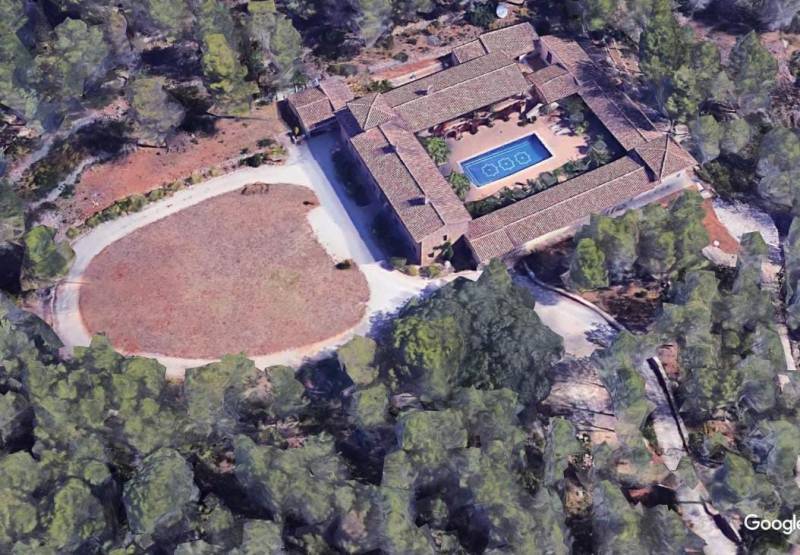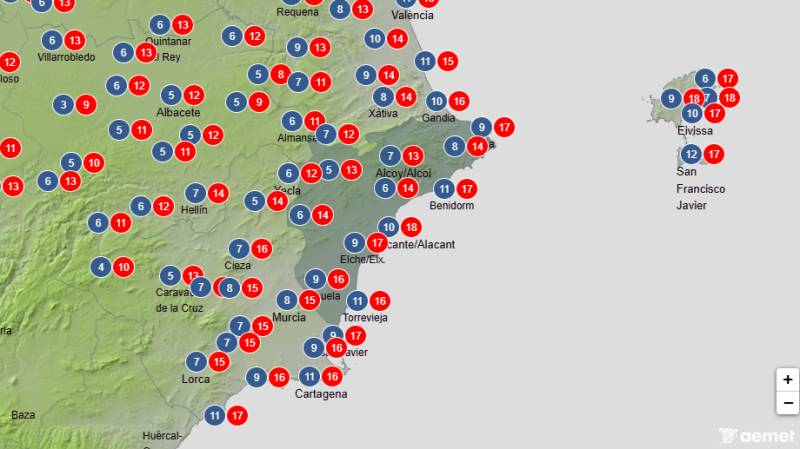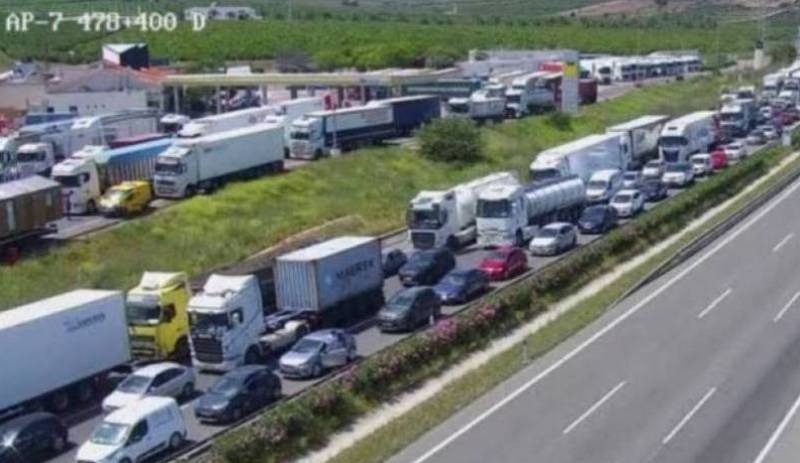

Guidelines for submitting articles to Mazarron Murcia
Hello, and thank you for choosing Mazarron Murcia to publicise your organisation’s info or event.
Mazarron Murcia is a website set up by Murcia Today specifically for residents of the urbanisation in Southwest Murcia, providing news and information on what’s happening in the local area, which is the largest English-speaking expat area in the Region of Murcia.
When submitting text to be included on Mazarron Murcia, please abide by the following guidelines so we can upload your article as swiftly as possible:
Send an email to editor@spaintodayonline.com or contact@murciatoday.com
Attach the information in a Word Document or Google Doc
Include all relevant points, including:
Who is the organisation running the event?
Where is it happening?
When?
How much does it cost?
Is it necessary to book beforehand, or can people just show up on the day?
…but try not to exceed 300 words
Also attach a photo to illustrate your article, no more than 100kb

The Diablesa and Caballero Cubierto, Santo Entierro del Cristo, Orihuela
These two unique traditions make Saturday night really special in the Orihuela Semana Santa
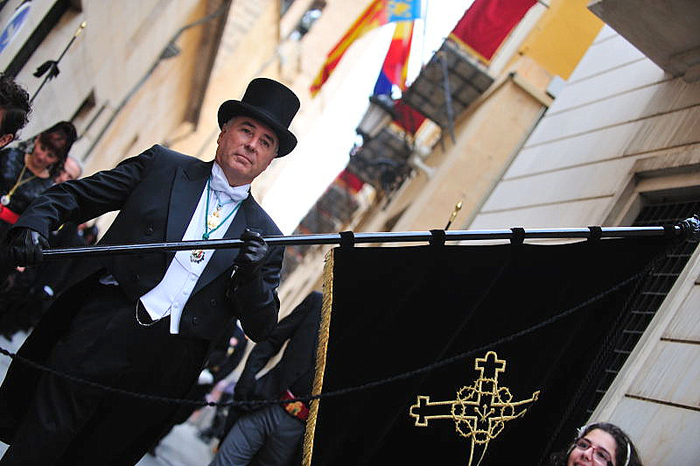
On the Saturday evening of Semana Santa week, Spain usually draws a sharp breath and slumps into an exhausted stupor, passion spent, shoulders bruised and aching, feet sore and torn following the exertion of the Good Friday night processions, taking a temporary break following the crucifixion of Christ before the resurrection on Easter morning.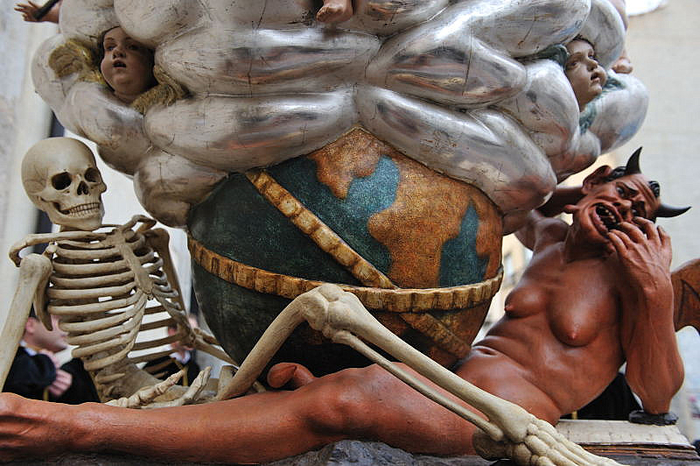
However, in Orihuela, one of the most important and unique processions of the Semana Santa celebrations takes place, the parade of the Santo Entierro del Cristo combining two of the unique features which give Semana Santa in Orihuela the status of International Tourist interest : The Diablesa and the Caballero Cubierto.
“La Diablesa” or “El Triunfo de la Cruz”, was produced by Nicolás de Bussy in around 1695 during a period 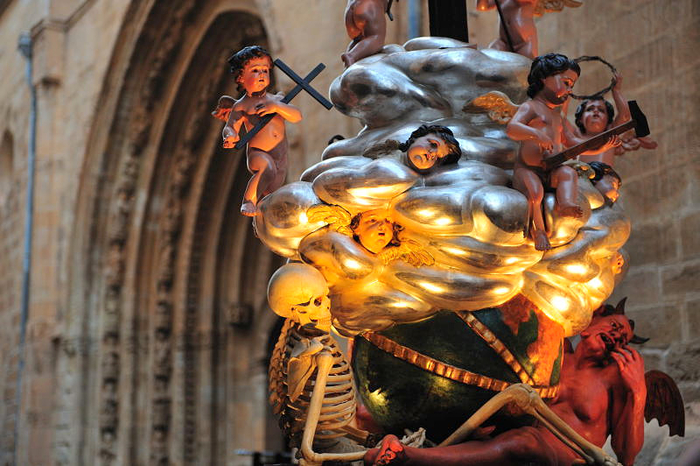 when Orihuela itself was undergoing extensive growth and creating wealth to invest in magnificent new convents and religious structures, as well as sculptures and artworks by the most important artists of the era. Nicolás De Bussy was originally from Strasbourg, but settled in the south-east of Spain, and most of his surviving works are to be found in the provinces of Murcia and Alicante.
when Orihuela itself was undergoing extensive growth and creating wealth to invest in magnificent new convents and religious structures, as well as sculptures and artworks by the most important artists of the era. Nicolás De Bussy was originally from Strasbourg, but settled in the south-east of Spain, and most of his surviving works are to be found in the provinces of Murcia and Alicante.
“La Diablesa” is an extraordinary representation designed to demonstrate how faith can overcome the evil 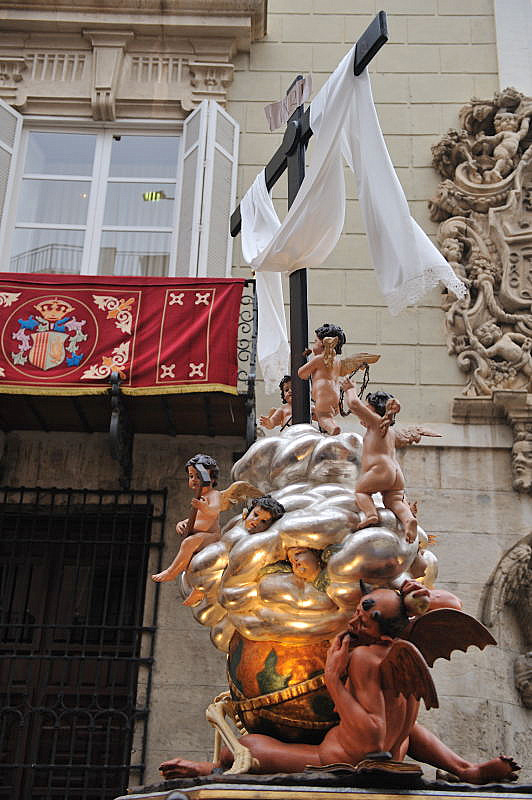 intents of the Devil. It must be remembered that when this sculpture was created in the 17th century, most of the population were illiterate, and pieces like this were important to show the triumph of everlasting life over death, of good over evil, of abstinence over indulgence, in the most visible way possible, glorifying the power of the cross and giving an illiterate population a focal point for worship as well as engendering respect for the power of the church.
intents of the Devil. It must be remembered that when this sculpture was created in the 17th century, most of the population were illiterate, and pieces like this were important to show the triumph of everlasting life over death, of good over evil, of abstinence over indulgence, in the most visible way possible, glorifying the power of the cross and giving an illiterate population a focal point for worship as well as engendering respect for the power of the church.
This devil is in a female form, a controversial choice of imagery in a world where the devil was always shown in a male personification. The glory of this piece is in the detail, the silken folds of the clouds, the muscles and sagging teats on the body of the she devil, her painted fingers clutching an apple to symbolise temptation, a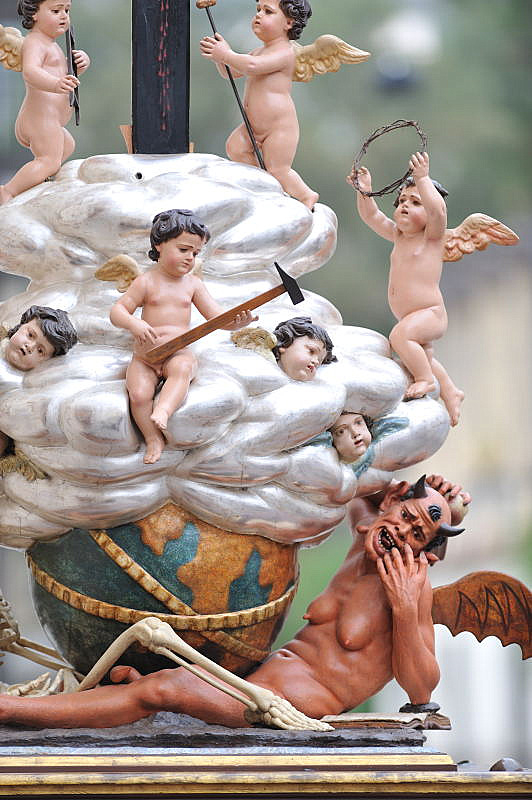 representation of the world as it was known at this date, so look at it closely. Religious art tends in the minds of many to become stereotyped, but a visit to the archaeological museum where she is on display throughout the year would be worthwhile even if this were the only item in it, and it leaves the visitor lamenting the fact that so many of De Bussy’s works were lost or destroyed during the madness and fear which gripped Spain on the eve of the Spanish Civil War.
representation of the world as it was known at this date, so look at it closely. Religious art tends in the minds of many to become stereotyped, but a visit to the archaeological museum where she is on display throughout the year would be worthwhile even if this were the only item in it, and it leaves the visitor lamenting the fact that so many of De Bussy’s works were lost or destroyed during the madness and fear which gripped Spain on the eve of the Spanish Civil War.
This sculpture was paid for by the agricultural workers guild and the torchbearers which precede it still come from the outlying agricultural pedanías of the Orihuela municipality, and the Diablesa is accompanied on her journey through Orihuela by the Mayors of these same districts as she passes through the streets of the city.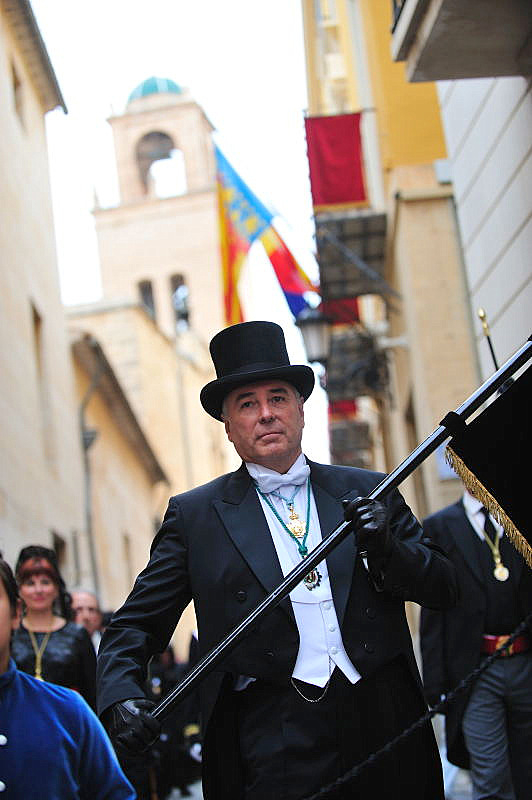
However, although she forms part of the procession, she is excluded from one of the key moments within it, as no representation of the devil is permitted to enter Spanish churches, so while the procession enters the Cathedral by one door, circles the altar and then leaves by the other, the Diablesa is refused entry and must wait in the street outside of the cathedral, rejoining the procession once it has left sacred ground.
The other tradition which is completely unique to Orihuela in this Saturday parade is that of the Caballero Cubierto.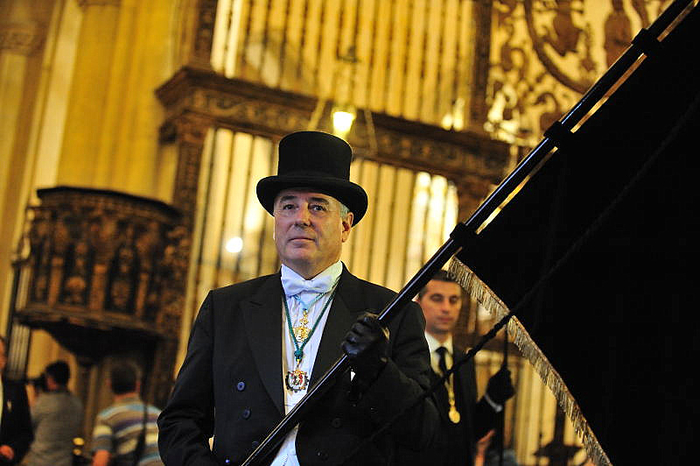
Throughout the year this figure is represented by a statue made by Cartagena sculptor Pedro Jordán Almarza next to the main entrance of the cathedral, but on this one evening of the year, the Caballero Cubierto himself parades in the flesh.
This one individual (the “covered gentleman”) leads the Saturday evening procession, wearing a top hat and 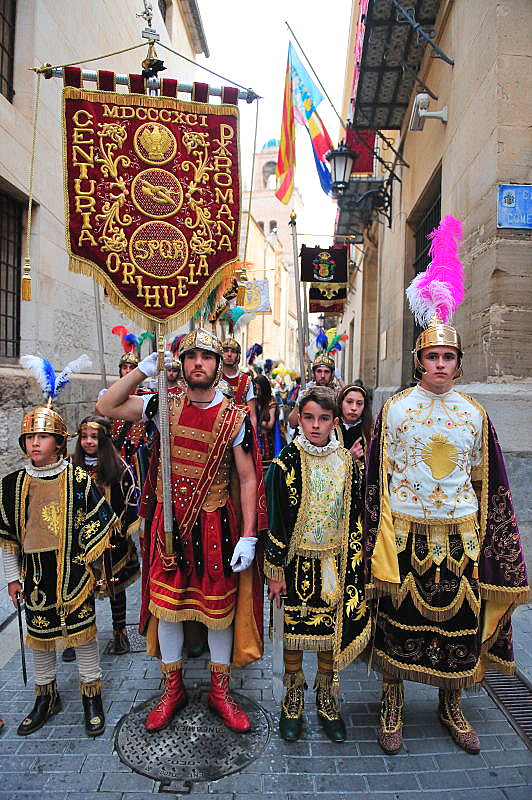 tails and carrying the banner of the city, on which is embroidered the motto awarded by King Pedro IV of Aragón in the 14th century, "Semper Prevaluit ensis Vester" (Your blade always prevailed), and reflects Orihuela’s valiant defence during four sieges in the “War of the Two Pedros”, a war of succession between Pedro IV and Pedro I of Castile which lasted from 1356 to 1369.
tails and carrying the banner of the city, on which is embroidered the motto awarded by King Pedro IV of Aragón in the 14th century, "Semper Prevaluit ensis Vester" (Your blade always prevailed), and reflects Orihuela’s valiant defence during four sieges in the “War of the Two Pedros”, a war of succession between Pedro IV and Pedro I of Castile which lasted from 1356 to 1369.
On reaching the Cathedral the person selected to represent the “Caballero Cubierto” leads the parade into the 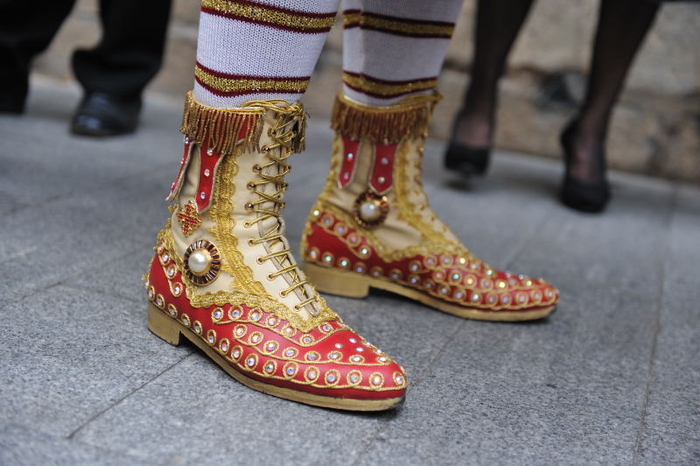 building, and is the only person not required to remove his hat inside, due to the special privilege granted in a papal bull dictated in 1620 by Pope Paul V.
building, and is the only person not required to remove his hat inside, due to the special privilege granted in a papal bull dictated in 1620 by Pope Paul V.
Hundreds of torchbearers and the Roman soldiers in their colourful costumes (and amazing shoes!) accompany the pasos participating in this parade, in which the figure of Jesus after his crucifixion is paraded for all to see, before the resurrection takes place in the early hours of Sunday morning.
Orihuela is again unusual in that it celebrates the resurrection of Christ just after midnight, its Resurrection 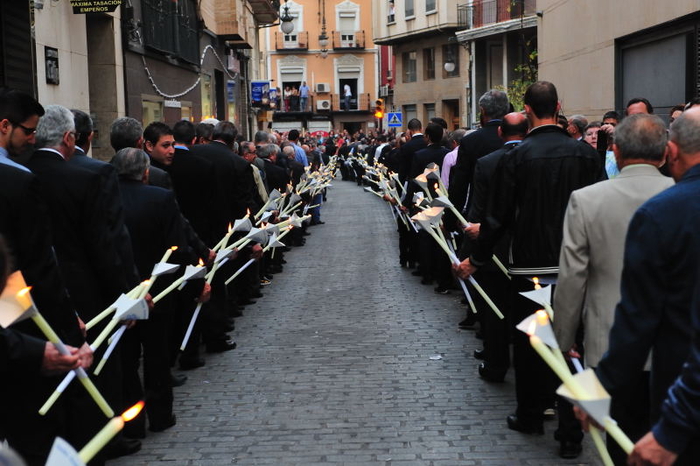 parade taking place in the middle of the night, unlike most other places where the early morning is chosen to bring the joy of the resurrection along with the first rays of early sunshine on Easter morning, Christ has risen, church bells ring out, the mood changes from mourning to celebration, and weary penitents can rest their aching limbs until preparations begin once again for another Semana Santa.
parade taking place in the middle of the night, unlike most other places where the early morning is chosen to bring the joy of the resurrection along with the first rays of early sunshine on Easter morning, Christ has risen, church bells ring out, the mood changes from mourning to celebration, and weary penitents can rest their aching limbs until preparations begin once again for another Semana Santa.














